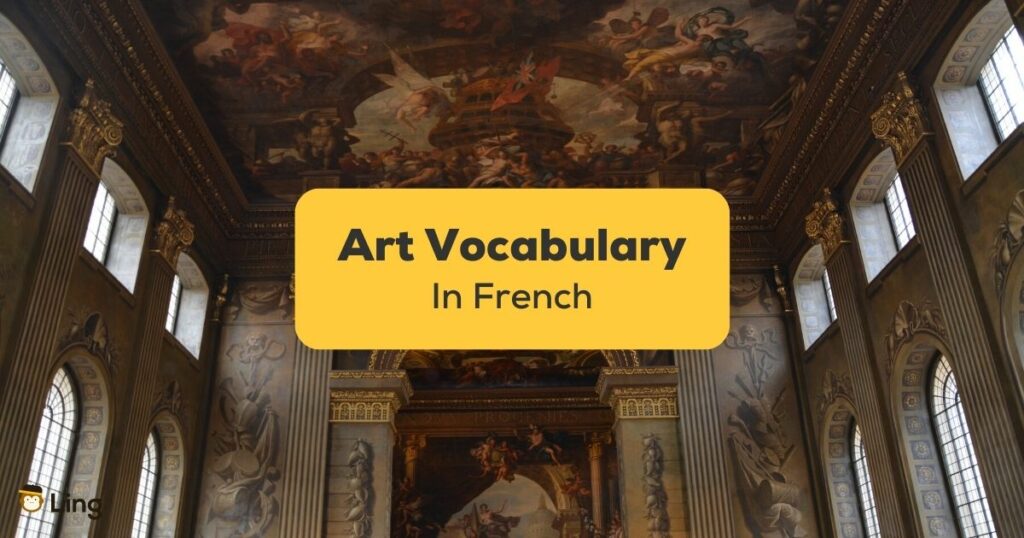France is a worldwide hub and cultural capital for art and artistic expression. For much of the 18th & 19th centuries, French artists revolutionized the genre and have spearheaded some of the most influential historical and artistic movements the world has ever seen.
The French are some of the most meticulous art collectors in the world, displaying famous works in over 1,200 famous museums and galleries across the country. Yes, that’s right … there are over a thousand places for you to visit and wander around beautiful art all over France!
Knowing basic French art vocabulary and expressions will heighten your enjoyment and increase your awareness of the insanely cool history and culture. For me, art is much more meaningful when I know its history and meaning.
So, take this essential guide and spend time learning these words and expressions. You never know what art enthusiasts you may meet while in a French museum, and how great would it be if you could converse with them in their native language? Let’s begin!
Fine Art & Painting Vocabulary In French
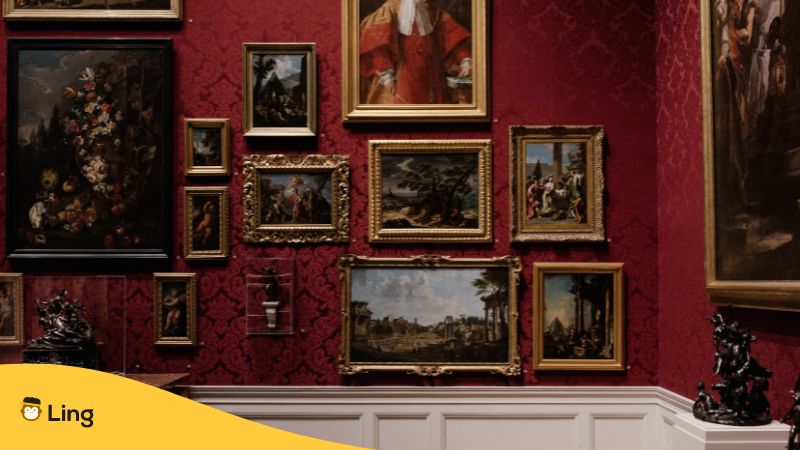
Suppose you’re strolling through the Louvre and want to describe a particularly stunning 18th-century neoclassical painting in front of you. The following words will help you out if you get stuck!
French Adjectives To Describe Art

Now we are starting to put the puzzle pieces together. You just learned over 40 French art nouns, but here are some adjectives to make your thoughts about art sound more sophisticated (like French culture!)
Museum-Related French Vocabulary
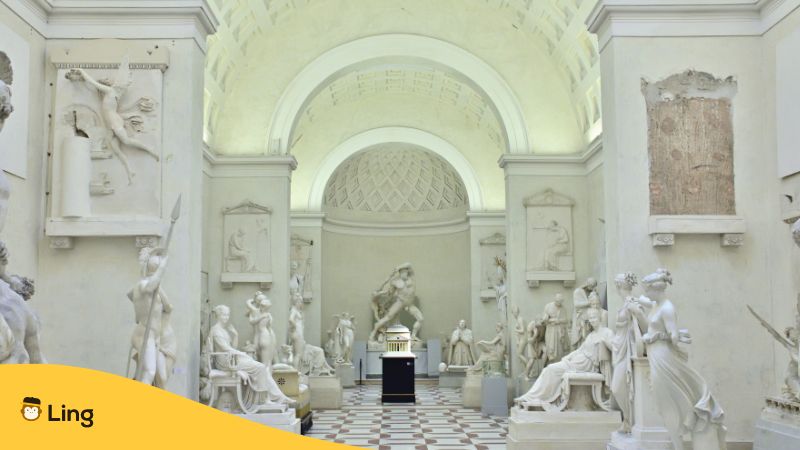
If you’re a real history nerd and like to understand the captions (called a museum label) on certain paintings in French museums or art galleries, then keep a careful eye on this list! It has everything you need to know.
More Art-Related Vocabulary In French
Now I know art is expressed in many different ways besides paintings in museums, so this list has vocabulary for all the other art forms, like sculpting or photography.
Unique List Of Shades In French
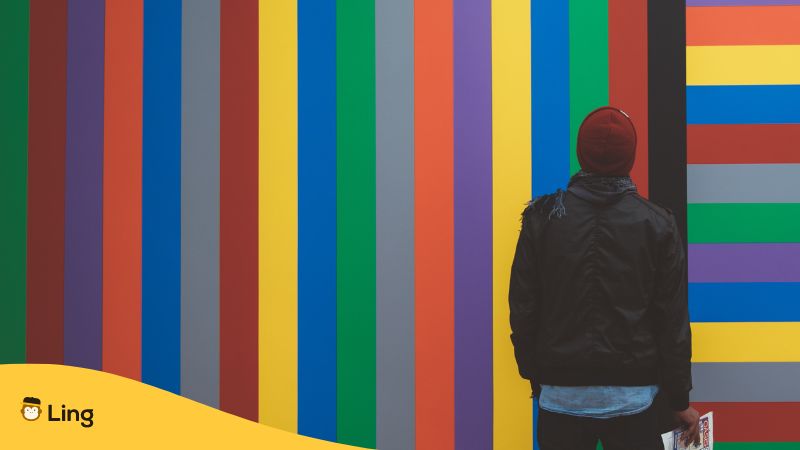
Check out Colors in French for a more full-bodied, in-depth look at the French color palette. In this article, however, I will focus on unique colors used as adjectives to describe a scene, painting, photograph, or drawing. Here is an extended list that may be useful to whip out at the Musee d’Orsay in Paris.
Tip: All French colors are masculine as nouns, but they can change to feminine if being used as an adjective (add an ‘e’ to feminine colors to make it grammatically correct).
More Words To Describe Hues In French
If the above wasn’t enough for you, here are more words that can express colors.
| English | French | Pronunciation |
| Blonde | Blonde | |
| Dark brown | Brun | |
| Chestnut brown | Châtain | |
| Red-head | Roux | |
| Light | Clair | |
| Dark | Foncé | |
| Bright | Vif | |
| Dull | Terne | |
| Fluorescent | Fluo |
Common French Expressions To Describe Art
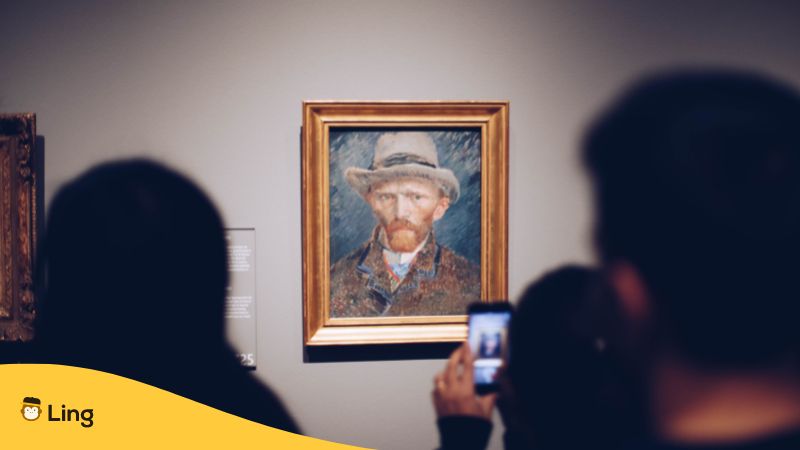
Now let’s put it all together. Whip one or two of these simple sentences in a French museum, and you’ll fit right in!
History Of French Art
France has been on the front line of the most influential artistic movements for hundreds of years. Many of the most famous artists in history either hailed from or studied in France. The powerhouse country played a pivotal role in the foundations of modern-day Europe and the preservation of fine arts. Without France’s contribution to reclaiming the arts, much of history would have been changed.
Perhaps the most prominent burst of life came from the Renaissance period in the 14th – 17th centuries. This time prompted a rediscovery of the arts, in which France helped define modern western culture. Stunning, opulent art was created for churches, palaces, museums, and galleries. People noted France for its haven of art and its importance on artistic expression at this time. Even today, France is perceived as a high-class, central stage for cultured society because of art.
Because of the legacy of French fine art, most people have a spiritual experience while visiting France museums for the first time. How wonderful would it be for you to speak about spectacular, historical art pieces in French … at a French museum … to a French person? Imagine how accomplished you’d feel! Keep reading this guide on French art vocabulary, and you’re one step closer. Let’s go!
French Baroque Art And Classicism
Arguably the golden age of French art was the seventeenth century. The Baroque period in European art was marked by an interest in dramatic lighting and dynamic movement. French Baroque painters such as Georges de La Tour and Charles Le Brun were known for their grandiose scenes that often included biblical or mythological themes. One of the most famous Baroque artists was the sculptor François Girardon. His marble statue, “Louis XIV on Horseback,” was commissioned by the king himself and remains a beloved work of French art.
French Rococo And Neoclassicism
Moving on to the Rococo era and neoclassicism of the early eighteenth century, French art and French painting took on a lighter, more playful tone. The Rococo style was characterized by intricate ornamentation and delicate pastel colours, and the famous French artists of the time often focused on scenes of everyday life, particularly in the courts and salons of the French aristocracy. Perhaps the most famous Rococo painter was Jean-Honoré Fragonard, whose works often depicted romantic and playful scenes, such as his painting “The Swing.” Another notable Rococo artist was Antoine Watteau, who created vibrant and elegant scenes that often included masquerades and fêtes galantes.
French Romanticism
The nineteenth century saw the rise of Romanticism in French art, which was characterized by a focus on emotion, individualism, and the beauty of nature. One of the most significant French artists and Romantic painters was French artist Eugène Delacroix, whose works often included themes of war, exoticism, and mythology. Delacroix’s painting “Liberty Leading the People” is a particularly iconic example of Romanticism, featuring a strong and heroic female figure leading the French people to the French Revolution against the French monarchy.
French Impressionist Movement
But perhaps the most famous French art movement of all is Impressionism, which emerged in the late 19th century. Impressionism was characterized by its use of light and colour to capture the beauty and essence of everyday life. French painters such as Claude Monet, Pierre-Auguste Renoir, and Edgar Degas were at the forefront of this movement, and their works continue to inspire and influence artists to this day. Monet’s famous paintings of water lilies and the Rouen Cathedral with its stunning stained glass are particularly famous in the art world, while Renoir’s scenes of Parisian life in the modern age and Degas’ ballet dancers remain beloved examples of French Impressionism.
20th-Century French Art
Moving into the 20th century, we find ourselves in the midst of the Cubist movement. Cubism was characterized by its use of geometric shapes and forms and was a departure from the more traditional styles of the past. Cubism followed the Impressionism and Post Impressionism of the early years of the century when artists were experimenting with content and colour to represent the emerging modern world.
Pablo Picasso and Georges Braque were two of the most prominent artists of this era, and their works continue to be celebrated for their innovative and groundbreaking nature and use of collage. Picasso’s “Les Demoiselles d’Avignon” is a particularly famous example of the fine art of Cubism, featuring distorted and fragmented figures in a brothel scene.
French Surrealist Movement
The Surrealist movement emerged in the 1920s and was characterized by its use of dreamlike imagery and the exploration of the subconscious mind. Salvador Dali, Rene Magritte, and Max Ernst were some of the most prominent artists of this era, and their contemporary artworks continue to challenge and inspire audiences today. Dali’s melting clocks and Magritte’s surreal juxtapositions of objects remain some of the most recognizable works of modern art in the world.

Learn French With Ling
You don’t need to be fluent in French to participate in art galleries and experience French museums. If you practice the above vocabulary and expressions, you’ll be more than equipped to impress native speakers as you pass by your favorite 19th-century impressionist Monet (without sounding too pretentious!)
If you need structure and genuinely helpful lessons and resources to continue your journey into learning French, then check out the Ling App! It is a user-friendly language-learning app with games, quizzes, and interactive features proven to help you learn a new language.
You can download it for free on the App Store and Play Store. What are you waiting for? If you start today, you’re one step closer to being prepared to traverse the most iconic French museums.
